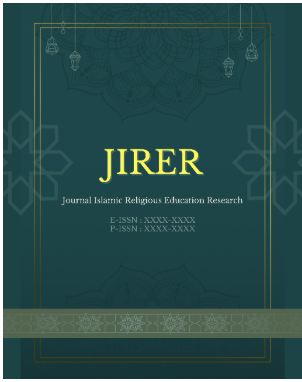Pengaruh Frekuensi Membaca Al-Qur'an Dengan Kemampuan Pemahaman Dan Penguasaan Bahasa Arab Di MA Attaraqie
Keywords:
Al-Qur’an, Arabic language, comprehension, mastery, correlationAbstract
This study aims to investigate whether there is a significant effect of the frequency of reading the Qur'an on students' ability to comprehend and master the Arabic language at Madrasah Aliyah Attaraqqie. A correlational quantitative approach was employed, involving 86 female students from grades 10 and 11 as the total sample. Data collection instruments included a Likert-scale questionnaire for the reading frequency variable (X1), and multiple-choice tests for comprehension (Y1) and mastery of Arabic (Y2). The results of the validity and reliability tests showed that all items in X1 and Y1 were valid and reliable, while Y2 had two items deemed less valid but still met reliability standards. Data analysis using Pearson correlation indicated that the relationships between X1 and Y1 (r = 0.088; p = 0.418) and X1 and Y2 (r = 0.103; p = 0.343) were not statistically significant. Therefore, it is concluded that the frequency of reading the Qur'an does not significantly affect students' comprehension and mastery of Arabic. These findings suggest the need for integrating Qur'anic reading with more systematic pedagogical approaches in Arabic language learning.
References
Akbar, R., Sukmawati, U. S., & Katsirin, K. (2023). Analisis Data Penelitian Kuantitatif. Jurnal Pelita Nusantara, 1(3). https://doi.org/10.59996/jurnalpelitanusantara.v1i3.350
Arikunto, S. (2014). Prosedur Penelitian: Suatu Pendekatan Praktis. Jakarta: Rineka Cipta.
Cohen, L., Manion, L., & Morrison, K. (2018). Research Methods in Education. United Kingdom: Routledge.
Junaidi, & Mulianah, B. (2020). Pengaruh Kefasihan Membaca Al-Qur’an Terhadap Keterampilan Membaca Pada Bidang Studi Bahasa Arab. El-Tsaqafah: Jurnal Jurusan PBA, 19(2), 199–215. https://doi.org/10.20414/tsaqafah.v19i2.2749
Krashen, S. (1985). The input hypothesis: Issues and implications. New York: Longman.
Krashen, S. (2006). Free reading. School Library Journal, 52(9), 42–45.
Mamuaya, Christian, N., Wahyudi, M. P., Syah, N., Arifin, M. Z., Kurniawan, J., … Sari, I. G. P. (2025). Metode Penelitian Kuantitatif. Padang: Azzia Karya Bersama.
Maulida, N., Agus Mulyana, M., & Syamsudin, D. (2024). Pengaruh Penguasaan Bahasa Arab Terhadap Kemampuan Menghafal Al-Qur’an. Tatsqifiy: Jurnal Pendidikan Bahasa Arab, 5(1), 63–70. https://doi.org/10.30997/tjpba.v5i1.11719
Muhamad, S., Farhan Mokoagow, A., & Abidin, M. (2023). Efektivitas Media Pembelajaran Interaktif Berbasis Lectora Inspire untuk Meningkatkan Keterampilan Membaca Bahasa Arab Siswa. Loghat Arabi: Jurnal Bahasa Arab Dan Pendidikan Bahasa Arab, 4(2), 159–174.
Nursiah, & Nur Fadilah Amin. (2017). Pengaruh Penguasaan Bahasa Arab Terhadap Kemampuan Menghafal Al-Qur’an Mahasiswi Semester II Ma’Had Al-Birr Makassar. Al-Maraji’: Jurnal Pendidikan Bahasa Arab, 1(1), 60–75.
Palupi, I. A. B., Djuniadi, D., & Ristanto, R. D. (2021). Penerapan E-Learning Berbasis Learning Management System Menggunakan Easyclass. Jurnal Penelitian Pendidikan, 38(1), 39–43. https://doi.org/10.15294/jpp.v38i1.31223
Riduwan. (2018). Skala Pengukuran Variabel-variabel Penelitian. Bandung: Alfabeta.
Sugiyono. (2018). Metode Penelitian Kuantitatif, Kualitatif, dan R&D (1st ed.). Bandung: Alfabeta.
Susanti, A. (2025). Pengaruh Keaktifan Mengikuti Kegiatan IPNU IPPNU Terhadap Motivasi Belajar PAI. LEARNING : Jurnal Inovasi Penelitian Pendidikan Dan Pembelajaran, 5(2), 695–705. https://doi.org/10.51878/learning.v5i2.5084
Ubaidillah, M., & Rostianingsih. (2024). TRANSFORMASI PENDIDIKAN DI PONDOK PESANTREN DALAM MEWUJUDKAN SUSTAINABLE DEVELOPMENT GOALS (SDGs): KAJIAN SISTEMATIS TERHADAP INOVASI DI ERA DIGITAL. Prosiding Konferensi Nasional Mahasiswa Bahasa Dan Sastra Arab, 1(1), 1332–1340.
Widayanti, T. (2021). Use of Google Form in Support of Data Collection for Student Scientific Work. Judimas (Jurnal Inovasi Pengabdian Kepada Masyarakat), 1(1), 85. https://doi.org/10.30700/jm.v1i1.1015
Zakia, Z., Musaddat, S., Indrawati, D., & Makki, M. (2024). Hubungan Keterampilan Membaca Terhadap Keterampilan Menulis Narasi Siswa Kelas IV di SDN 26 Cakranegara. LEARNING : Jurnal Inovasi Penelitian Pendidikan Dan Pembelajaran, 4(3), 411–421. https://doi.org/10.51878/learning.v4i3.3151
Zulham, Z., & Lubis, K. (2022). Islam Dan Toleransi. ANSIRU PAI : Pengembangan Profesi Guru Pendidikan Agama Islam, 6(2), 116. https://doi.org/10.30821/ansiru.v6i2.14649
Downloads
Published
Issue
Section
License
Copyright (c) 2025 JIRER JOURNAL ISLAMIC RELIGIOUS EDUCATION RESEARCH

This work is licensed under a Creative Commons Attribution-NonCommercial-ShareAlike 4.0 International License.






